2016 Lawn thread
Discussion
As it rained hard today I noticed right at the edge of my patio my grass puddled all the way along.
Further investigation with a fork has revealed where the 12 spare patio slabs were lifted from. No idea why they did it, the previous owners were total idiots. Didnt bother to dig out the base so its grass on a non permeable base layer FFS.
Further investigation with a fork has revealed where the 12 spare patio slabs were lifted from. No idea why they did it, the previous owners were total idiots. Didnt bother to dig out the base so its grass on a non permeable base layer FFS.
I have a feeling I'll be digging a French drain along the side of my garden.
Moved in during the Easter time, and all looked fine, but with anything more than a light shower we get the some mental puddling all the way along the boundary.
Next door neighbour has lived there since about 1784 so know the history of everything, he tells me we're all on clay anyway, but that our garden was raised by about 6" with even more clay when someone up the road built a garage and the previous owner accepted the spoil from it.
I know the water isn't going anywhere, but if I can at least give it somewhere to be other than the top surface it should help a little bit right? I known plenty about drainage, but f*ck all about gardens, so if I can at least prevent puddling at the surface will that be a good starting point?
Moved in during the Easter time, and all looked fine, but with anything more than a light shower we get the some mental puddling all the way along the boundary.
Next door neighbour has lived there since about 1784 so know the history of everything, he tells me we're all on clay anyway, but that our garden was raised by about 6" with even more clay when someone up the road built a garage and the previous owner accepted the spoil from it.
I know the water isn't going anywhere, but if I can at least give it somewhere to be other than the top surface it should help a little bit right? I known plenty about drainage, but f*ck all about gardens, so if I can at least prevent puddling at the surface will that be a good starting point?
My lawn runs slightly downhill towards the house. I've only been here a year, but it seems the norm in the winter is for it to be a little squelchy at the house end, though seemingly not enough or not for long enough for moss to be a huge problem.
Yesterday it rained heavily on already waterlogged ground, at the house end some grass is just about in a puddle. First time this has happened, hopefully it will dry up and not happen too often.
First time this has happened, hopefully it will dry up and not happen too often.
Yesterday it rained heavily on already waterlogged ground, at the house end some grass is just about in a puddle.
 First time this has happened, hopefully it will dry up and not happen too often.
First time this has happened, hopefully it will dry up and not happen too often.Hi, I need some help please. My lawn looks ok at first glance:
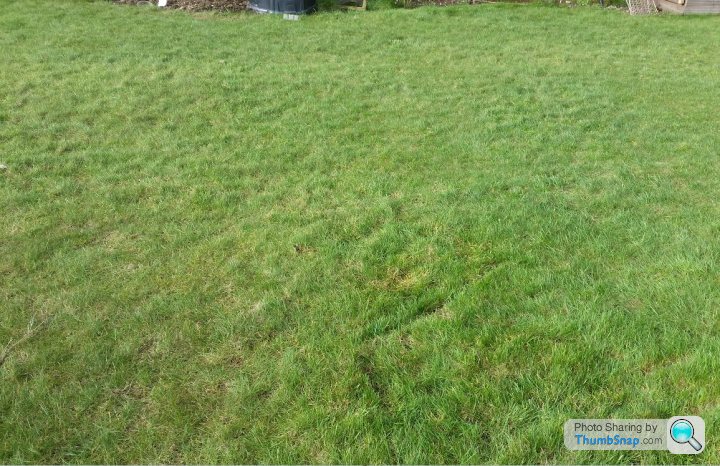
However, looking more up close, it doesn't look anywhere near as good:
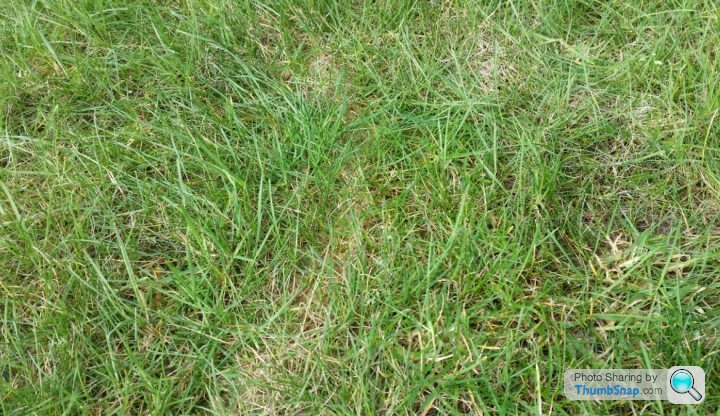
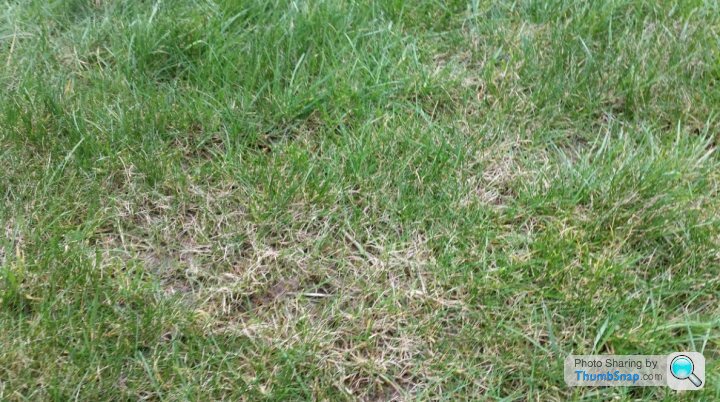
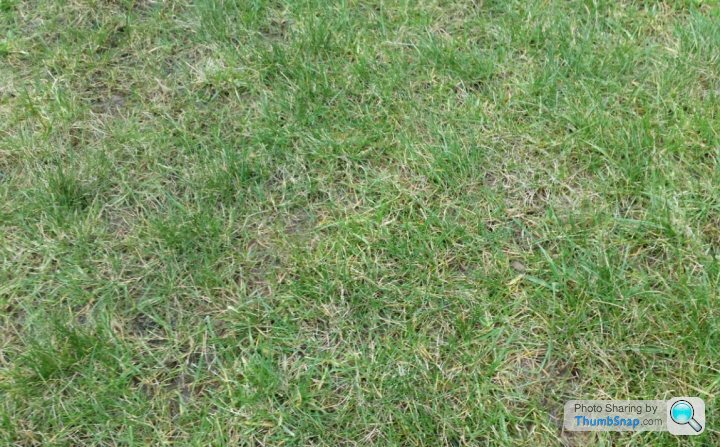
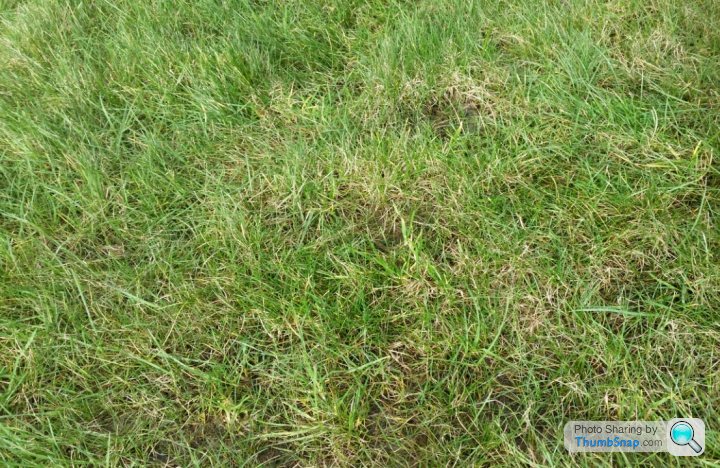
The lawn is mainly fescue (new build) that I seeded myself in July 2014. Last year, I tried scarifying, cutting it higher, feeding it and aerating, but I can't seem to get the lawn any better than it is right now. It never seems to grow very much and the kids go on it quite a lot, as the soil is very dry (mainly sand and gravel) and it is south facing so gets lots of sun.
Should I keep going with the work i'm doing, and wait for it to get better itself? Or am I setting my expectations of it too high and the amount of use it is getting be affecting it, therefore meaning I should reseed with something ryegrass based?
Thanks

However, looking more up close, it doesn't look anywhere near as good:




The lawn is mainly fescue (new build) that I seeded myself in July 2014. Last year, I tried scarifying, cutting it higher, feeding it and aerating, but I can't seem to get the lawn any better than it is right now. It never seems to grow very much and the kids go on it quite a lot, as the soil is very dry (mainly sand and gravel) and it is south facing so gets lots of sun.
Should I keep going with the work i'm doing, and wait for it to get better itself? Or am I setting my expectations of it too high and the amount of use it is getting be affecting it, therefore meaning I should reseed with something ryegrass based?
Thanks
If it's a new build, how's the soil underneath? Does it have a good deep rootzone or is there builder's rubble and stones lurking just under the surface, particularly on the more poorly looking patches? Have you measured the pH level? If not it'd be worth getting an initial basic soil test done to give you some idea of what's going on with the soil.
From the photos, the grass just generally looks a bit poorly rather than diseased so it's lacking something that it needs. I'd try giving it some iron as that'll help with photosynthesis if it's lacking, and at this time of year with short days, low sun and more cloud than not it needs all the help it can get.
In this photo:

I can't quite see if that's some decomposing grass from where it's been cut when long and left to lie or if there's a slimy mould around it. With all the rain mould is perhaps not unexpected. Is drainage in that part noticeably worse? The yellowing grass blades near it could be an indication of too much water. If it's from cutting too much off and leaving it lying on the ground smothering things then don't
A sandy soil means that nutrients get washed away quickly. I'd try to feed on a little and often basis if you can rather than twice yearly heavy doses. Even though it's technically winter, the mild weather we've had means that it hasn't really gone dormant so a light feed with a low nitrogen fertiliser wouldn't do any harm currently. I had to give mine a light cut and feed a couple of weeks ago.
Come the spring I'd plan on overseeding with a good quality seed to help fill in the thinner areas. As always, cut little and often and make sure that your mower's blades are sharp. If using a cylinder mower check the reel is correctly adjusted. Now would be a good time to get the mower serviced if it hasn't been for a while, before the world and his wife starts turning up with their mowers for servicing at the first sign of warm weather.
If the grass is taking a battering from the kids playing, then a fescue blend with Poa pratensis (smooth stalked meadow grass) can help with resilience with higher wear tolerance and improved self repair. That may not be necessary, and just overseeding troubled patches through the year will suffice.
From the photos, the grass just generally looks a bit poorly rather than diseased so it's lacking something that it needs. I'd try giving it some iron as that'll help with photosynthesis if it's lacking, and at this time of year with short days, low sun and more cloud than not it needs all the help it can get.
In this photo:

I can't quite see if that's some decomposing grass from where it's been cut when long and left to lie or if there's a slimy mould around it. With all the rain mould is perhaps not unexpected. Is drainage in that part noticeably worse? The yellowing grass blades near it could be an indication of too much water. If it's from cutting too much off and leaving it lying on the ground smothering things then don't

A sandy soil means that nutrients get washed away quickly. I'd try to feed on a little and often basis if you can rather than twice yearly heavy doses. Even though it's technically winter, the mild weather we've had means that it hasn't really gone dormant so a light feed with a low nitrogen fertiliser wouldn't do any harm currently. I had to give mine a light cut and feed a couple of weeks ago.
Come the spring I'd plan on overseeding with a good quality seed to help fill in the thinner areas. As always, cut little and often and make sure that your mower's blades are sharp. If using a cylinder mower check the reel is correctly adjusted. Now would be a good time to get the mower serviced if it hasn't been for a while, before the world and his wife starts turning up with their mowers for servicing at the first sign of warm weather.
If the grass is taking a battering from the kids playing, then a fescue blend with Poa pratensis (smooth stalked meadow grass) can help with resilience with higher wear tolerance and improved self repair. That may not be necessary, and just overseeding troubled patches through the year will suffice.
Followed last year's thread with interest.
First thing I did was sack my gardener who basically turned up whenever he liked (fortnightly as a rule) and basically left the grass far too long and could never cut it properly as it was always too long in the first place.
So had the use of a decent mower and made sure all the leaves were cleared quickly, didn't expect to still be cutting on new year's day! But it looks pretty good compared to its usual jungle state.
Have bought a scarifier to use when it's a bit warmer. Have had greenthumb for years so not too much weed etc. Will put up pictures later, plan to look after the lawn this year with a bit of tlc, hopefully nothing too extreme, although would like to look to bin greenthumb and do that myself too.
First thing I did was sack my gardener who basically turned up whenever he liked (fortnightly as a rule) and basically left the grass far too long and could never cut it properly as it was always too long in the first place.
So had the use of a decent mower and made sure all the leaves were cleared quickly, didn't expect to still be cutting on new year's day! But it looks pretty good compared to its usual jungle state.
Have bought a scarifier to use when it's a bit warmer. Have had greenthumb for years so not too much weed etc. Will put up pictures later, plan to look after the lawn this year with a bit of tlc, hopefully nothing too extreme, although would like to look to bin greenthumb and do that myself too.
jagnet said:
If it's a new build, how's the soil underneath? Does it have a good deep rootzone or is there builder's rubble and stones lurking just under the surface, particularly on the more poorly looking patches? Have you measured the pH level? If not it'd be worth getting an initial basic soil test done to give you some idea of what's going on with the soil.
From the photos, the grass just generally looks a bit poorly rather than diseased so it's lacking something that it needs. I'd try giving it some iron as that'll help with photosynthesis if it's lacking, and at this time of year with short days, low sun and more cloud than not it needs all the help it can get.
In this photo: I can't quite see if that's some decomposing grass from where it's been cut when long and left to lie or if there's a slimy mould around it. With all the rain mould is perhaps not unexpected. Is drainage in that part noticeably worse? The yellowing grass blades near it could be an indication of too much water. If it's from cutting too much off and leaving it lying on the ground smothering things then don't
A sandy soil means that nutrients get washed away quickly. I'd try to feed on a little and often basis if you can rather than twice yearly heavy doses. Even though it's technically winter, the mild weather we've had means that it hasn't really gone dormant so a light feed with a low nitrogen fertiliser wouldn't do any harm currently. I had to give mine a light cut and feed a couple of weeks ago.
Come the spring I'd plan on overseeding with a good quality seed to help fill in the thinner areas. As always, cut little and often and make sure that your mower's blades are sharp. If using a cylinder mower check the reel is correctly adjusted. Now would be a good time to get the mower serviced if it hasn't been for a while, before the world and his wife starts turning up with their mowers for servicing at the first sign of warm weather.
Thanks for all the advice. I've got a basic pH tester, and the soil is about pH6.5. Moisture seems ok too. It could be stones beneath the surface causing problems, however I raked the soil over myself and removed them before I seeded, though only to a depth of about 4-6 inches.From the photos, the grass just generally looks a bit poorly rather than diseased so it's lacking something that it needs. I'd try giving it some iron as that'll help with photosynthesis if it's lacking, and at this time of year with short days, low sun and more cloud than not it needs all the help it can get.
In this photo: I can't quite see if that's some decomposing grass from where it's been cut when long and left to lie or if there's a slimy mould around it. With all the rain mould is perhaps not unexpected. Is drainage in that part noticeably worse? The yellowing grass blades near it could be an indication of too much water. If it's from cutting too much off and leaving it lying on the ground smothering things then don't

A sandy soil means that nutrients get washed away quickly. I'd try to feed on a little and often basis if you can rather than twice yearly heavy doses. Even though it's technically winter, the mild weather we've had means that it hasn't really gone dormant so a light feed with a low nitrogen fertiliser wouldn't do any harm currently. I had to give mine a light cut and feed a couple of weeks ago.
Come the spring I'd plan on overseeding with a good quality seed to help fill in the thinner areas. As always, cut little and often and make sure that your mower's blades are sharp. If using a cylinder mower check the reel is correctly adjusted. Now would be a good time to get the mower serviced if it hasn't been for a while, before the world and his wife starts turning up with their mowers for servicing at the first sign of warm weather.
Re the photo, I've zoomed in a bit to the original - does this help?
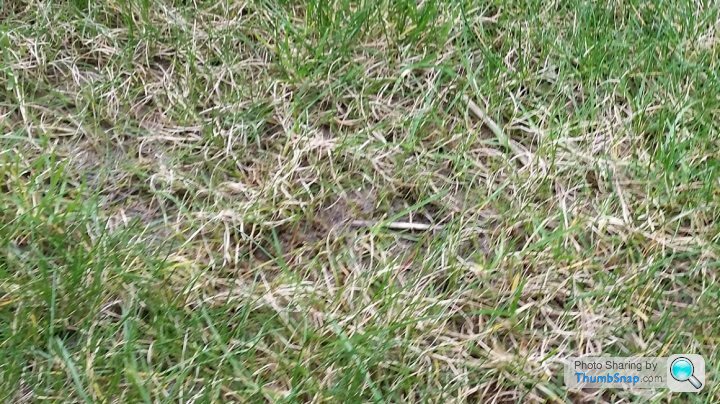
I think i've captured the area that you're talking about. The brown grass seems to be dead grass that was directly growing in the soil and dead, rather than decomposing clippings. The fuzzy greyish bit in the middle is the soil itself - it's very sandy and gravelly (on top of a small hill) but reasonably deep for a new build (30cm or so), so it drains very well, and is still dry and mud-free now (even after all the rain). A better picture of the soil from when I seeded it:
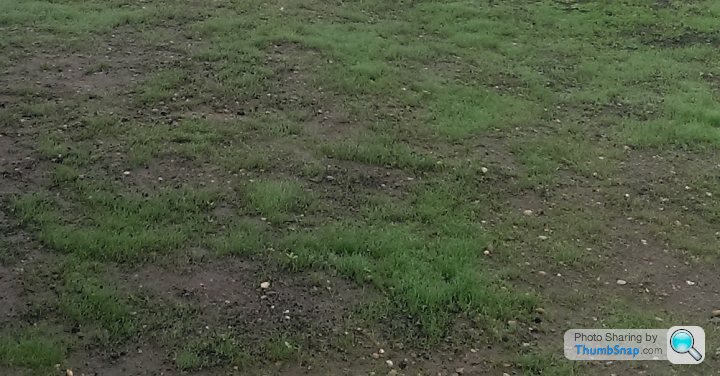
The slightly darker bits are where I chucked some topsoil bags down to level it slightly, when the kids went out in it and fell over (the wife let them on it while I was at work). It's particularly annoying how grass doesn't seem to grow so well, as everything else (all my plants and trees) are growing non-stop.
I'm getting the feeling that I need to feed it more regularly. I've currently got Lebanon Country Club 18-4-12. I guess it could be iron, so i'll try some. Other than that, it could be some compaction in the subsoil, however that would probably mean digging it up and starting over - something both the wife and kids would hate me for.
davesaat said:
The fuzzy greyish bit in the middle is the soil itself
Yep, that's the bit that struck me as possibly being something unpleasant. If it's just the soil then that's ok.davesaat said:
it's very sandy and gravelly (on top of a small hill) but reasonably deep for a new build (30cm or so), so it drains very well, and is still dry and mud-free now (even after all the rain).
That's a decent depth which is a bonus. Some new builds can be an absolute nightmare for hiding rubble under half an inch of topsoil. If it is as free draining as it sounds then nutrients being washed out could well be an issue. The problem is even worse on 'new ground' where it hasn't yet had chance to develop good structure after being dug around during the build.
Your pH level looks ok. Perhaps very slightly on the high side of ideal for fine fescues but not enough to warrant concern.
Given how sandy the soil is, I would be tempted to top dress with a sand/compost blend to help with nutrient and water retention. If you can combine it with aeration to help get the compost into the rootzone then all the better. I would also think about the use of compost tea. That's good for developing the all important fungi and bacteria in sandy soils, which is so important to the health of turf.
There shouldn't be a need to start again on it as on the whole there's good colour and growth in the turf from the looks of it. Give it time and tlc and I reckon it should come good.
Also, with it being fescues, south facing and without shade issues as far as I can see you don't need to keep the cut as high as the average lawn. In your situation a shorter cut might be more beneficial, say around 1 inch in winter/summer and 3/4 of an inch in times of good growth. That could well mean cutting twice a week when it's growing at its fastest.
westberks said:
although would like to look to bin greenthumb and do that myself too.
Absolutely no reason not to  There's nothing particularly special about their fertilisers and weed killers, after all the fertilisers still contain Nitrogen, Phosphorous and Potassium. There's plenty of places to get hold of good quality fertilisers (The Lawnsmith, Pitchcare, etc). The added bonus is that as you get to understand your lawn's particular needs you can tailor the fertiliser to suit, as opposed to applying the same generic treatment to all lawns no matter what grass types, soil types, etc they have.
There's nothing particularly special about their fertilisers and weed killers, after all the fertilisers still contain Nitrogen, Phosphorous and Potassium. There's plenty of places to get hold of good quality fertilisers (The Lawnsmith, Pitchcare, etc). The added bonus is that as you get to understand your lawn's particular needs you can tailor the fertiliser to suit, as opposed to applying the same generic treatment to all lawns no matter what grass types, soil types, etc they have.With a healthy lawn comes less need for weedkillers, and spot spraying any as they appear should be more than enough. That imho is in turn better for the turf than dousing it in weedkiller unnecessarily.
The one thing that they can apply that isn't so accessible are growth regulators, but tbh they're a bit overkill for domestic lawns and whilst nice to have if you can incorporate them properly into a turf care regime, aren't essential by any means. For the most part I wouldn't trust the average franchise to be tailoring them to anything particularly anyway.
jagnet said:
westberks said:
although would like to look to bin greenthumb and do that myself too.
Absolutely no reason not to  There's nothing particularly special about their fertilisers and weed killers, after all the fertilisers still contain Nitrogen, Phosphorous and Potassium. There's plenty of places to get hold of good quality fertilisers (The Lawnsmith, Pitchcare, etc). The added bonus is that as you get to understand your lawn's particular needs you can tailor the fertiliser to suit, as opposed to applying the same generic treatment to all lawns no matter what grass types, soil types, etc they have.
There's nothing particularly special about their fertilisers and weed killers, after all the fertilisers still contain Nitrogen, Phosphorous and Potassium. There's plenty of places to get hold of good quality fertilisers (The Lawnsmith, Pitchcare, etc). The added bonus is that as you get to understand your lawn's particular needs you can tailor the fertiliser to suit, as opposed to applying the same generic treatment to all lawns no matter what grass types, soil types, etc they have.With a healthy lawn comes less need for weedkillers, and spot spraying any as they appear should be more than enough. That imho is in turn better for the turf than dousing it in weedkiller unnecessarily.
The one thing that they can apply that isn't so accessible are growth regulators, but tbh they're a bit overkill for domestic lawns and whilst nice to have if you can incorporate them properly into a turf care regime, aren't essential by any means. For the most part I wouldn't trust the average franchise to be tailoring them to anything particularly anyway.
My front garden was a grim gravel drive this time last year and I ended up turning it back into a garden, turfing most of it and planting flowers and the start of a hedge.
The grass grew very nicely, as did the flowers, but this winter's horrific weather has devastated the lawn. It's no more. Practically just mud now with a bit of dying grass left.
Most annoying. Not sure whether it is poor quality turf, the continuous onslaught from the clouds or some sort of disease in the grass. My daffodils are growing and the hedge plant still appears to be growing. Just the grass which has been affected.
ETA -
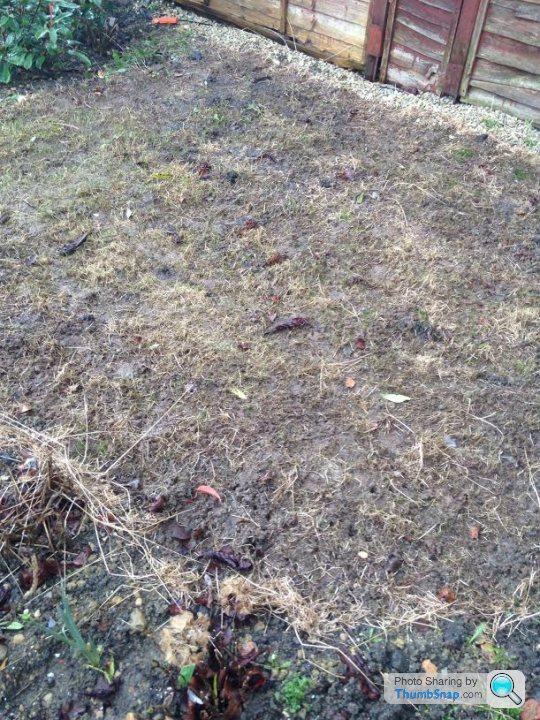
The grass grew very nicely, as did the flowers, but this winter's horrific weather has devastated the lawn. It's no more. Practically just mud now with a bit of dying grass left.
Most annoying. Not sure whether it is poor quality turf, the continuous onslaught from the clouds or some sort of disease in the grass. My daffodils are growing and the hedge plant still appears to be growing. Just the grass which has been affected.
ETA -

Edited by camshafted on Monday 8th February 12:22
Hi All,
Could be a decent thread to watch could this!
We're thinking of putting our house on the market at the back end of 2016.
What are the key dates within a year for treating a lawn? Could do with getting the lawn as tip-top as possible as it's one of the first things that prospective buyers will see.
Our front lawn is pretty much in the shade of the house all day and tends to be quite bouncy with moss, whereas the back grows quickly but can be patchy depending on where the dog pees!
Generally, just gets cut once a fortnight for a few weeks of the year, and then weekly through the warmer summer months. Not been cut since October and looking quite messy now to honest. Very wet though at the moment so no intention to touch for a couple of weeks at least. At best, I put a bit of supermarket strength 'feed and weed' type stuff on.
Are there other things I should be doing around this time?
Could be a decent thread to watch could this!
We're thinking of putting our house on the market at the back end of 2016.
What are the key dates within a year for treating a lawn? Could do with getting the lawn as tip-top as possible as it's one of the first things that prospective buyers will see.
Our front lawn is pretty much in the shade of the house all day and tends to be quite bouncy with moss, whereas the back grows quickly but can be patchy depending on where the dog pees!
Generally, just gets cut once a fortnight for a few weeks of the year, and then weekly through the warmer summer months. Not been cut since October and looking quite messy now to honest. Very wet though at the moment so no intention to touch for a couple of weeks at least. At best, I put a bit of supermarket strength 'feed and weed' type stuff on.
Are there other things I should be doing around this time?
Sign up to the Lawnsmith diary email here: http://www.lawnsmith.co.uk/lawn-diary. Should give you a good indication of what you should be doing.
My lawn is on the most horrific clay and is so wet this winter that I couldn't mow it if I tried. It's also very heavily shaded by deciduous trees so is predominantly moss in many places.
Walking on it absolutely mullers it, I've just laid a couple of land drains to try to intercept water flowing in to it in certain places and that has ruined the affected areas. I've also been adding grit sand in the boggiest areas (2 tonnes and counting).
I moved in last September and the previous owner cheerfully admitted he'd never done anything but mow it for 26 years.
There's probably half an acre of fiddly bits all in so my programme has to be fairly low-maintenance, as there's no shortage of other gardening to do. I'm in this house for the long haul so happy to beetle away at this for years.
My plan is to use a proprietary weed & feed this spring, then apply a fair bit of top soil (another 2 tonnes?) as a top-dressing and overseed it with a fairly butch grass seed.
Thoughts?
Walking on it absolutely mullers it, I've just laid a couple of land drains to try to intercept water flowing in to it in certain places and that has ruined the affected areas. I've also been adding grit sand in the boggiest areas (2 tonnes and counting).
I moved in last September and the previous owner cheerfully admitted he'd never done anything but mow it for 26 years.
There's probably half an acre of fiddly bits all in so my programme has to be fairly low-maintenance, as there's no shortage of other gardening to do. I'm in this house for the long haul so happy to beetle away at this for years.
My plan is to use a proprietary weed & feed this spring, then apply a fair bit of top soil (another 2 tonnes?) as a top-dressing and overseed it with a fairly butch grass seed.
Thoughts?
familyguy1 said:
Really want to get on scarifying it out, then Ferrous Sulphate it, then feed and seed. Given how warm it is (relatively speaking) when could I start this ?
You could treat with ferrous sulphate any time over the winter, so do that straight away if you want to. Also given how mild it has been you could feed with a low-nitrogen autumn/winter fertiliser now, then feed with a spring/summer feed in six to eight weeks' time.However, I don't think any lawns are growing vigorously enough yet to recover properly from scarifying, and the soil temperature is still far too cold for seed to germinate. Both of those jobs need leaving for at least another six to eight weeks. When it's a bit warmer and the lawn is growing strongly, scarify then overseed.
Dr Mike Oxgreen said:
You could treat with ferrous sulphate any time over the winter, so do that straight away if you want to. Also given how mild it has been you could feed with a low-nitrogen autumn/winter fertiliser now, then feed with a spring/summer feed in six to eight weeks' time.
However, I don't think any lawns are growing vigorously enough yet to recover properly from scarifying, and the soil temperature is still far too cold for seed to germinate. Both of those jobs need leaving for at least another six to eight weeks. When it's a bit warmer and the lawn is growing strongly, scarify then overseed.
wouldn't applying the ferrous sulphate now kill the moss, but then leave it sitting there kind of defeating the object ? sorry if that's an obvious question.However, I don't think any lawns are growing vigorously enough yet to recover properly from scarifying, and the soil temperature is still far too cold for seed to germinate. Both of those jobs need leaving for at least another six to eight weeks. When it's a bit warmer and the lawn is growing strongly, scarify then overseed.
camshafted said:
That's not looking so good 
I'd start by making sure that the ground is well prepared. Ensure that there's no stones in there and that it's got good drainage. You need a good 6 inches for the rootzone, 9 would be better. I'd definitely mix in some compost, and if drainage is poor some sharp sand unless it's a heavy clay soil.
How's the lawn in terms of shade? Most off the shelf turf isn't so good in shade so you'll need to look at dedicated shade happy seed if that's the case.
Gassing Station | Homes, Gardens and DIY | Top of Page | What's New | My Stuff




